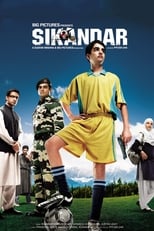Sikandar opens with the activities of a small Muslim village in a beautiful mountainous setting. As school lets out, children stream downhill to the market plaza. A child spies a loose soccer ball, kicks it, and it explodes, blowing apart everything and everyone in the plaza. Welcome to routine life in Kashmir.
From there, we meet Sikandar (Parzaan Dastur), a young teenager from Kupwara, near the Pakistan border. His parents were killed by militants, so he lives with his doting aunt and uncle, and he loves to play soccer. He is the target of 3 bullies at school but is befriended by Nasreen (Ayesha Kapoor), a newcomer in town who says her father calls her the flower of Kashmir.
While walking to school, they discover a pistol — a Beretta 92 FS — “the favorite companion of the first Jihadis”. For Sikandar, the gun becomes “black magic” that he uses to chase away those who threaten him. But it also attracts Jihadi leader Zahgeer (the charismatic Arunoday Singh), who teaches the boy how to shoot an unnamed target in exchange for something Sikandar really wants: a washer-cum-dryer for his auntie.
Where is this going?
The first half of the film sets the stage, and in the second half, the gun’s black magic becomes a kiss of death in a community that is over-run with terrorism and lives by an eye for an eye. Terrorism is plotted or exercised by all factions: the Mukhtar’s government, the occupying Indian army, and the Jihadi militants. All three factions deploy the children to carry out their schemes.
Writer-Director Piyush Jha went on to become a writer of crime novels in India, and his film is not so much political but is more like a convoluted murder mystery, where everyone is to blame.
In the film, death is so prevalent and life is so cheap, that the characters barely react to the bombings and shootings. Violence is also in a sense aided by the Maulvi leaders of the mosque, who refuse to intervene.
And maybe that is Jha’s point, that people are inured to death and terrorism. So one can easily convince a child that a bullet in a politician’s head is a just way to earn a washing machine, or that a bomb is a way to peace. Believing that people can easily forgive and forget terrorism is the only way the ending makes some sense.
Kashmir and soccer
I spent way too much time trying to understand this movie. In a way, it was good, because I had to look back to my only other review of a Kashmiri movie, the 2010 documentary Inshallah, Football. While the documentary was filmed only 2 years later, it shows a young man in urban Srinagar, just 50 miles away, where terrorism is more a thing of the past. It’s quite a contrast that Sikandar shows life in a small rural village continuously affected by terrorism, and where modern conveniences are a wonder. Read the Inshallah, Football review for a brief explanation of the conflicts in Kashmir.
The movie was shot primarily in the areas of Pahalgam and Betab Valley, providing beautiful scenery that looks very much like Yosemite.
The soccer is pretty minimal, and much of it is represented by Sikandar carrying cleats slung over his shoulder and wearing a bright yellow kit that makes him easy to spot. It seemed like there was a sudden change in the plot, where the Jihadis were stuffing soccer balls with bombs for some big event. But that thread evaporated, thankfully. The most soccer thing in this film is that Parzaan Dastur looks so much like a young Sunil Gulati, former head of US Soccer.
In conclusion
I only recommend this film if you want to see a rural side of Kashmir. Since the film is meant to be more of a thriller, I’m not sure how accurate any of the portrayals are. Strangely, I did not realize this was a Bollywood production until an engagement party dance scene was inserted late in the story.
The film and acting are well done, but like most Bollywood films, Sikandar is overly long. If you like a languid pace and a confounding ending, this could be the film for you.
6 Soccer Movie Mom Rating = 6
Resources:
- Released: 2009-08-21 (India)
- In Hindi and possibly some Urdu with English sub-titles
- 1 hour 42 minutes
- I watched this on Amazon
- IMDB
- WIKI
- Director: Piyush Jha on Facebook @thePiyushJha
- Stars: Parzaan Dastur (Sikandar) , Ayesha Kapur (Nasreen) aka Ayesha Kapoor
- Watch an unofficial trailer

